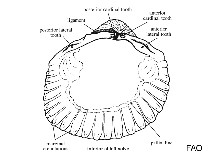Parvicardium pinnulatum (Conrad, 1831)
Northern dwarf cockle| Native range | All suitable habitat | Point map | Year 2050 |

|
| This map was computer-generated and has not yet been reviewed. |
| Parvicardium pinnulatum AquaMaps Data sources: GBIF OBIS |
Google image | No image available for this species;
drawing shows typical species in Cardiidae.
Classification / Names Κοινά ονόματα | Συνώνυμα | CoL | ITIS | WoRMS
Bivalvia | Cardiida | Cardiidae
Environment: milieu / climate zone / εύρος βάθους / distribution range Οικολογία
; εύρος βάθους 9 - 183 m (Αναφ. 83435). Temperate; 72°N - 34°N, 78°W - 37°E
Distribution Χώρες | Περιοχές FAO | Οικοσυστήματα | Παρουσίες | Εισαγωγές
Northern Atlantic and the Mediterranean Sea.
Length at first maturity / Μέγεθος / Weight / Age
Γεννητική Ωρίμανση: Lm ? range ? - ? cm
Life cycle and mating behavior Γεννητική Ωρίμανση | Αναπαραγωγή | Γεννοβολία | Eggs | Γονιμότητα | Larvae
Main reference
Αναφορές | Συντονιστής | Συνεργάτες
Darr, A., M. Gogina and M.L. Zettler 2014 Detecting hot-spots of bivalve biomass in the south-western Baltic Sea. Journal of Marine Systems 134:69-80. (Αναφ. 95989)
IUCN Red List Status
(Αναφ. 130435: Version 2025-1)
CITES status (Αναφ. 108899)
CMS (Αναφ. 116361)
Threat to humans
Human uses
| FishSource |
Εργαλεία
Περισσότερες πληροφορίες
Διαδικτυακές πηγές
BHL | BOLD Systems | CISTI | DiscoverLife | FAO(Publication : search) | Fishipedia | GenBank (genome, nucleotide) | GloBI | Gomexsi | Google Books | Google Scholar | Google | PubMed | Δέντρο Ζωής | Wikipedia (Go, αναζήτηση) | Zoological Record



